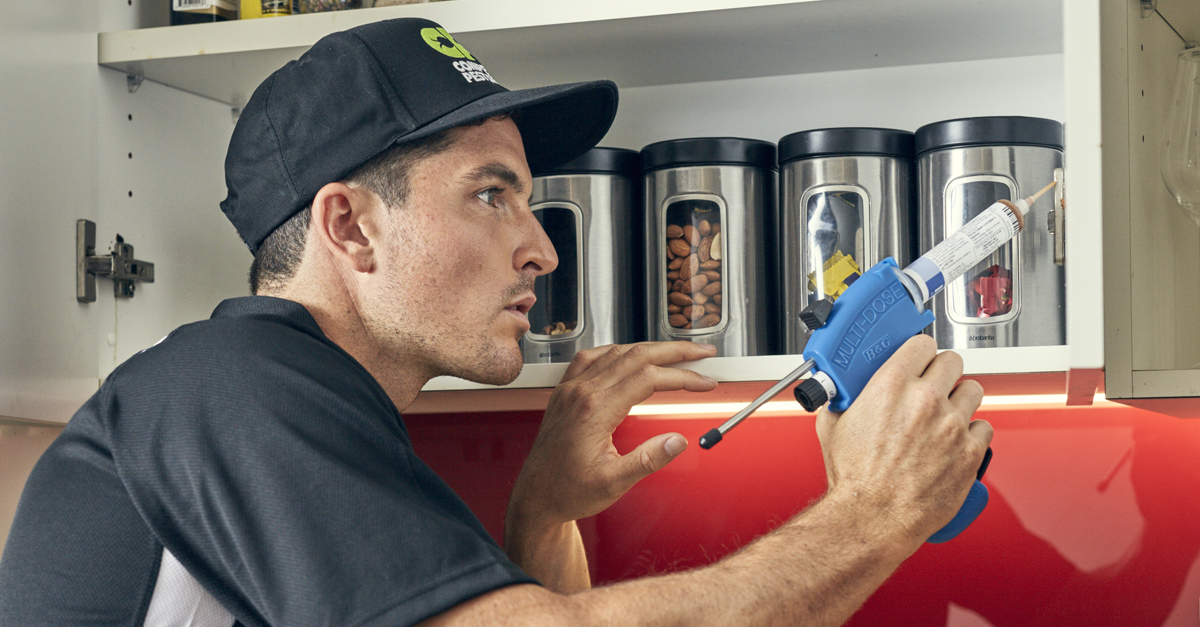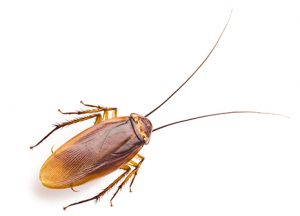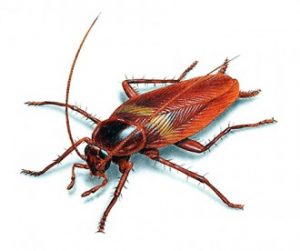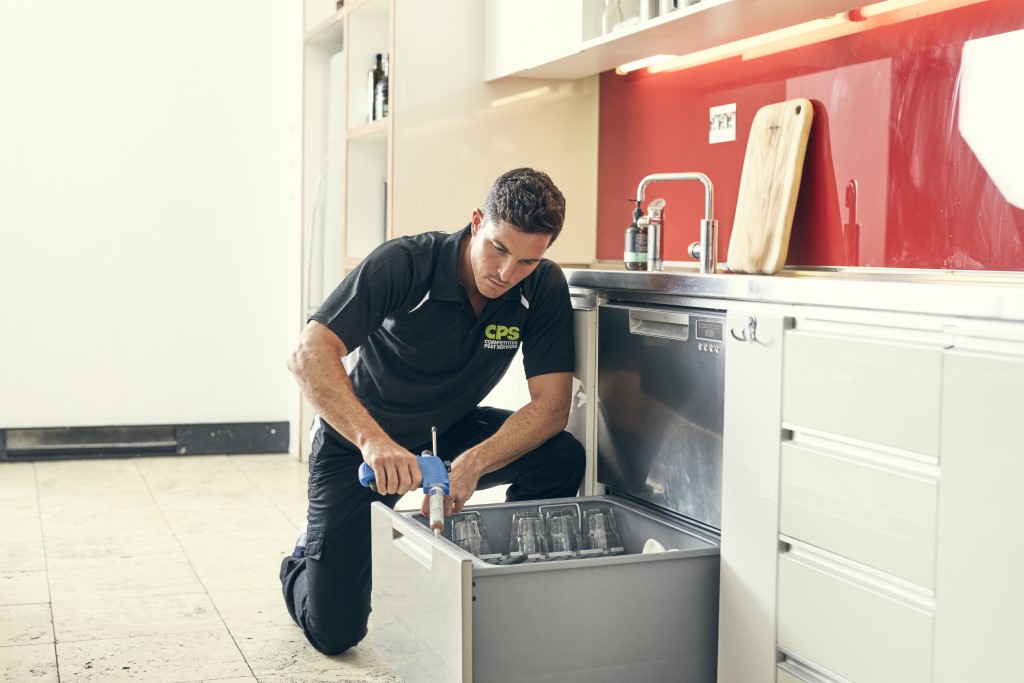
The Australian Cockroach is often mistaken for the American as they are similar in appearance. However it is slightly smaller than the American cockroach and has yellow margins around the thorax, accompanied by yellow streaks down the sides of its wings base. The Australian cockroach is also a very good flyer but mostly during warmer weather and prefers warmer climates, however it can survive indoors during colder weather as long as water is available, so warm, moist conditions are ideal. It is also a scavenger feeder but unlike its relatives it prefers decaying matter and plants. It is often seen scavenging for food in the yard in warmer weather and will live under leaf litter or shrubbery in the garden beds.
Identifying Types of Cockroaches:
Like the American cockroach, the Australian cockroach does not like light and if found in the home it will be more common at night, usually darting away when you enter the room. If a large infestation is in the home, there is often a distinct odour. Droppings and vomit marks are normally visible on cupboards and hinges inside cupboards and drawers. A thorough pest treatment needs to be done before the problem gets worse.
AMERICAN COCKROACHES

American cockroach adults grow to an average length of around 4 centimetres, and about 7 millimetres tall. They are reddish brown and have a yellowish margin on the body region behind the head. Immature cockroaches resemble adults except that they are wingless. The insect can travel quickly, often darting out of sight when someone enters a room, and can fit into small cracks and under doors despite its fairly large size. It is considered one of the fastest running insects. It has a pair of large compound eyes each having over 2000 individual lenses, and is a very active night insect that shuns light.
American cockroaches generally live in moist areas, but can survive in dry areas if they have access to water. They prefer warm temperatures around 29 degrees and do not tolerate cold temperatures. In residential areas, these cockroaches live in basements and sewers, and may move outdoors into yards during warm weather. These cockroaches are common in cracks and crevices of your home, roof voids, subfloors, and pathways abutting homes. The American cockroach is a scavenger that feeds on decaying organic matter and a variety of other foods.
AUSTRALIAN COCKROACH

The Australian Cockroach is often mistaken for the American as they are similar in appearance. However it is slightly smaller than the American cockroach and has yellow margins around the thorax, accompanied by yellow streaks down the sides of its wings base. The Australian cockroach is also a very good flyer but mostly during warmer weather and prefers warmer climates, however it can survive indoors during colder weather as long as water is available, so warm, moist conditions are ideal. It is also a scavenger feeder but unlike its relatives it prefers decaying matter and plants. It is often seen scavenging for food in the yard in warmer weather and will live under leaf litter or shrubbery in the garden beds.
Like the American cockroach, the Australian cockroach does not like light and if found in the home it will be more common at night, usually darting away when you enter the room. If a large infestation is in the home, there is often a distinct odour. Droppings and vomit marks are normally visible on cupboards and hinges inside cupboards and drawers. A thorough pest treatment needs to be done before the problem gets worse.
GERMAN COCKROACHES

German cockroaches are the hardest cockroach to control and are the biggest nuisance in Sydney and Brisbane. They are very active and often infestations are large. They are around 12-16mm in length, have chewing mouth parts and are light brown with two dark stripes down the pronotum. They do have wings but will rarely fly, the reproductive cycle is extremely fast and the female lays egg capsules containing 30-48 eggs. One German cockroach can produce 20,000 young annually! The German cockroach will eat almost anything but prefers starchy foods like potatoes, rice and cereals. They can be anywhere in the home but are mostly found in the kitchen because of their food source and constant source of water. They frequent cupboards and warmer appliances in the home, such as microwaves, dishwashers, ovens, fridge motors and compressors.
Severe infestations can cause damage to appliances and can also leave an odour. They are social insects and will often be together in large groups around your appliances. A treatment should be carried out on the property as soon as German Cockroaches are spotted, because if there is one, there will be more. You can help the problem through proper hygiene. Cleaning dishes after every meal, keeping bench tops free of food and scraps, frequent mopping and even pulling out ovens and fridges and cleaning under and behind them will help eliminate the population.
BROWN BANDED COCKROACH

The Brown Banded cockroach is a small species of cockroach. It has lightly coloured bands across the wings and it is often confused with the Australian cockroach by the untrained eye. The Brown Banded doesn’t need a lot of moisture and therefore has a much wider distribution area. It will feed on all organic and decaying matter, and is more likely to be found in homes than in yards.
They prefer warmer places and can be often found in shower recesses, behind pictures, or in and around televisions and other appliances. The female will deposit her egg capsules in furniture such as lounges or the underside of tables. Each egg capsule will contain 14-16 eggs and she will produce approximately 20 egg cases in her lifetime. Eggs hatch within 1-2 months, and the nymphs will develop within 3-9 months. Adults will live for about 6 months. They are most active at night and when disturbed can move rapidly, even jumping and flying.
Smoky Brown Cockroach

Another common cockroach in Sydney is the smoky brown cockroach. Commonly found in areas that are moist, warm and somewhat sheltered from the elements, smoky browns are a nuisance in homes and businesses throughout the city. They are between 3mm to 33mm in length with wings that are longer than body (males) or wings that overlap that abdomen (females).
As opposed to other cockroaches, smoky browns live predominantly outdoors. They then enter buildings at night to find food, which they’ll proceed to contaminate with salivary fluid, harmful bacteria and excrement. They are opportunistic and will feed on scraps, dead insects and plant material. They’ve also been found in sinks and basins drinking water.
The development time of a smoky brown cockroach depends on the environmental conditions. However, it’s generally believed that most female smoky browns live for 218 days on average while males live for 215 days. During her lifespan a female will also produce an average of 10 egg sacks with roughly 20 eggs per sack. These sacks are attached to a protected or sheltered surface where they’ll remain until the eggs hatch and become nymphs. The nymphs then take between 6 to 12 months to develop into adults.
Signs of a cockroach infestation
Cockroaches are active at all times of the year. This means that infestations can occur whether it’s spring, autumn, winter or summer. Sings of a cockroach infestation include significant evidence of “spotting,” which is the technical term for cockroach vomit and faeces, in corners or other hiding places. Some other signs that your home or business is suffering from a cockroach infestation includes egg cases or skins/husks that are left behind once a cockroach has moulted. There may even be a suspicious smell if the cockroach infestation is big enough.
Tips for the prevention of cockroaches
Cockroaches require three things in order to survive and thrive: food, water and shelter. This means that the best tip for preventing cockroach infestations is to eliminate one or all of these things. This can be done through regular sanitation of your home.
Here at Competitive Pest Control in Sydney, we recommend cleaning spilled food and dirty dishes before they can accumulate. In addition to using a garbage bin with a tight-fitting lid. Not leaving pet food out, closing your dishwasher after usage, fixing any areas of moisture such as leaky taps and filling all cracks and crevices in will also prevent cockroaches from invading your property.
Cockroach control measures
If you believe your cockroach problem is out of hand, the best option is to give our friendly and highly trained team a call. We will use cockroach baits, total release aerosols, pump sprays and other pesticides to eliminate your infestation. Note that all techniques are undertaken so as to cause minimal inconvenience to your home life. We also use environmentally friendly chemicals during the extermination process. With our help, you can get rid of cockroaches quickly and safely. That means no more droppings in the kitchen cupboards and no more scattering cockroaches when you turn the lights on at night.






 Instagram
Instagram  LinkedIn
LinkedIn